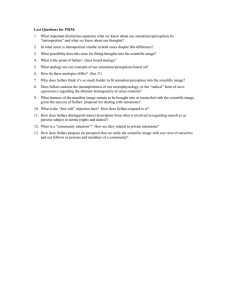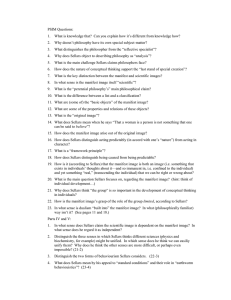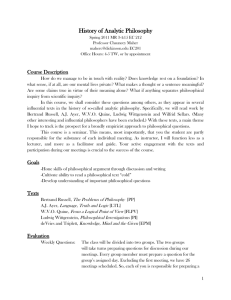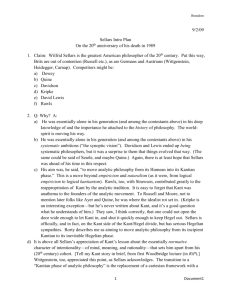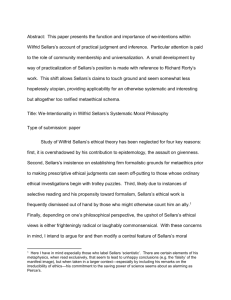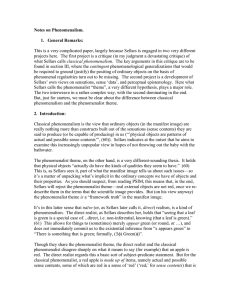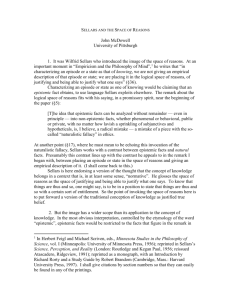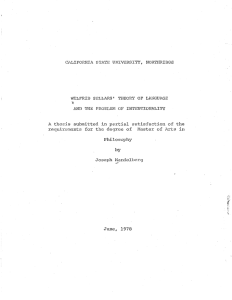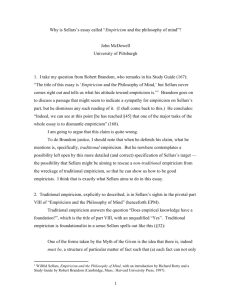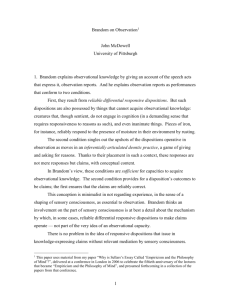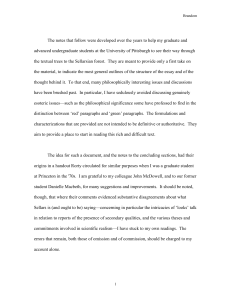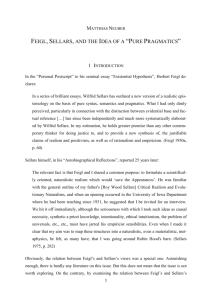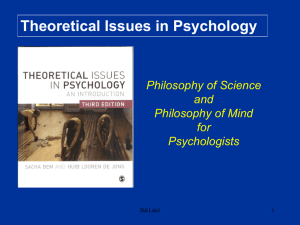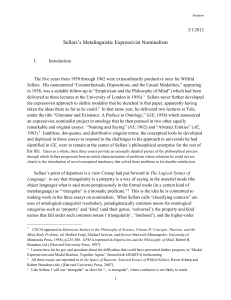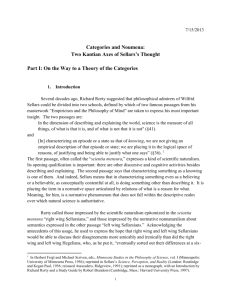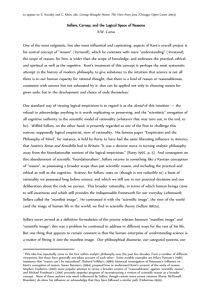Annotated bibliography part 2
advertisement
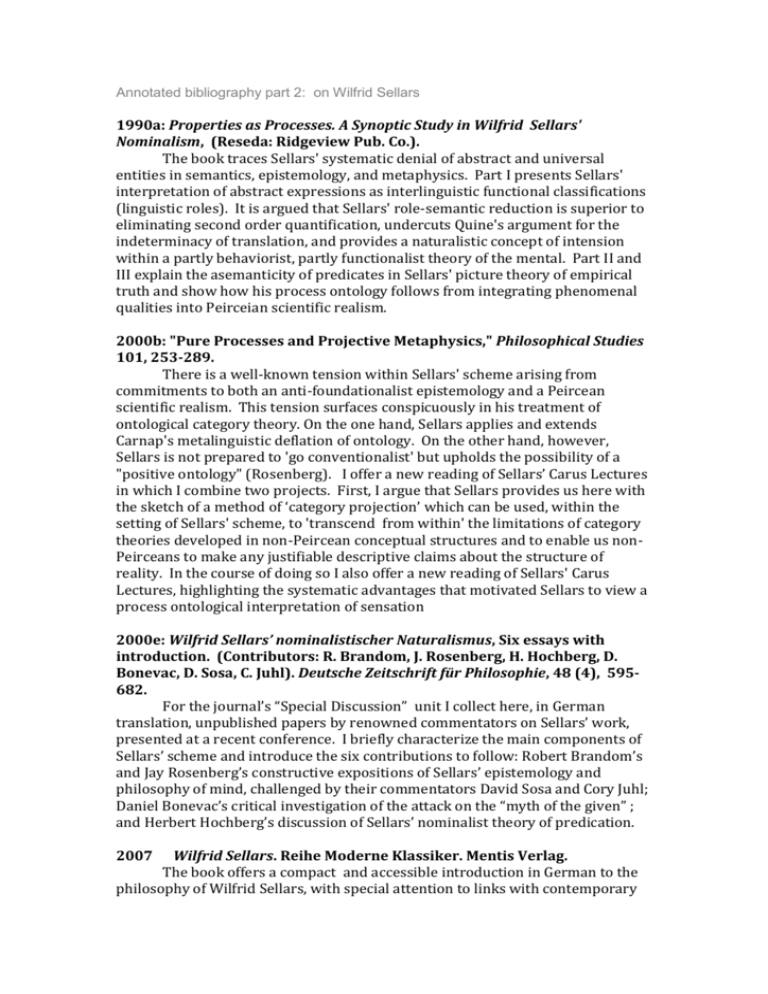
Annotated bibliography part 2: on Wilfrid Sellars 1990a: Properties as Processes. A Synoptic Study in Wilfrid Sellars' Nominalism, (Reseda: Ridgeview Pub. Co.). The book traces Sellars' systematic denial of abstract and universal entities in semantics, epistemology, and metaphysics. Part I presents Sellars' interpretation of abstract expressions as interlinguistic functional classifications (linguistic roles). It is argued that Sellars' role-semantic reduction is superior to eliminating second order quantification, undercuts Quine's argument for the indeterminacy of translation, and provides a naturalistic concept of intension within a partly behaviorist, partly functionalist theory of the mental. Part II and III explain the asemanticity of predicates in Sellars' picture theory of empirical truth and show how his process ontology follows from integrating phenomenal qualities into Peirceian scientific realism. 2000b: "Pure Processes and Projective Metaphysics," Philosophical Studies 101, 253-289. There is a well-known tension within Sellars' scheme arising from commitments to both an anti-foundationalist epistemology and a Peircean scientific realism. This tension surfaces conspicuously in his treatment of ontological category theory. On the one hand, Sellars applies and extends Carnap's metalinguistic deflation of ontology. On the other hand, however, Sellars is not prepared to 'go conventionalist' but upholds the possibility of a "positive ontology" (Rosenberg). I offer a new reading of Sellars’ Carus Lectures in which I combine two projects. First, I argue that Sellars provides us here with the sketch of a method of ‘category projection’ which can be used, within the setting of Sellars' scheme, to 'transcend from within' the limitations of category theories developed in non-Peircean conceptual structures and to enable us nonPeirceans to make any justifiable descriptive claims about the structure of reality. In the course of doing so I also offer a new reading of Sellars' Carus Lectures, highlighting the systematic advantages that motivated Sellars to view a process ontological interpretation of sensation 2000e: Wilfrid Sellars’ nominalistischer Naturalismus, Six essays with introduction. (Contributors: R. Brandom, J. Rosenberg, H. Hochberg, D. Bonevac, D. Sosa, C. Juhl). Deutsche Zeitschrift für Philosophie, 48 (4), 595682. For the journal’s “Special Discussion” unit I collect here, in German translation, unpublished papers by renowned commentators on Sellars’ work, presented at a recent conference. I briefly characterize the main components of Sellars’ scheme and introduce the six contributions to follow: Robert Brandom’s and Jay Rosenberg’s constructive expositions of Sellars’ epistemology and philosophy of mind, challenged by their commentators David Sosa and Cory Juhl; Daniel Bonevac’s critical investigation of the attack on the “myth of the given” ; and Herbert Hochberg’s discussion of Sellars’ nominalist theory of predication. 2007 Wilfrid Sellars. Reihe Moderne Klassiker. Mentis Verlag. The book offers a compact and accessible introduction in German to the philosophy of Wilfrid Sellars, with special attention to links with contemporary research in the philosophy of mind. Unlike other introductions to Sellars' thought, the book works out in greater detail the process-ontological roots of Sellars' naturalism. 2009 Functioning Between Reasons and Causes: On Picturing, in: W. de Vries (ed.), Empiricism, Perceptual Knowledge, Normativity, and Realism, Oxford University Press, pp. 247-283. In EPM Sellars argues that mental contents as such cannot be caused, rejecting the empiricist notion of mental representation. In Sellars’ view perceivers causally “picture” their environment in perception: physical processes are causally correlated with the perceiver’s neurophysiological processes that exhibit certain functional relationships and thus can be attributed content. This chapter argues that “picturing”, the link between the “causal order” and the “logical space of reasons”, is best understood as non-linear processing in orientation systems with emergent levels of functionality and normativity. First, it is analyzed which process configurations “picture”, i.e., form an orientation system for agent navigation that does not involve predication. Second, it is discussed in which sense “pictured” items can be said to be real and Sellars’ transcendental argument for scientific realism is briefly reconstructed. In conclusion “picturing” is related to recent work on natural functions and antirepresentational accounts of cognition. Keywords: mental representation, function, normativity, perception, orientation, predication, realism
